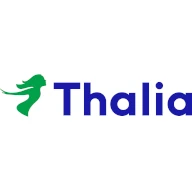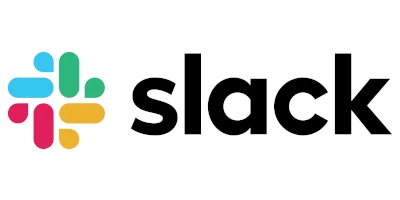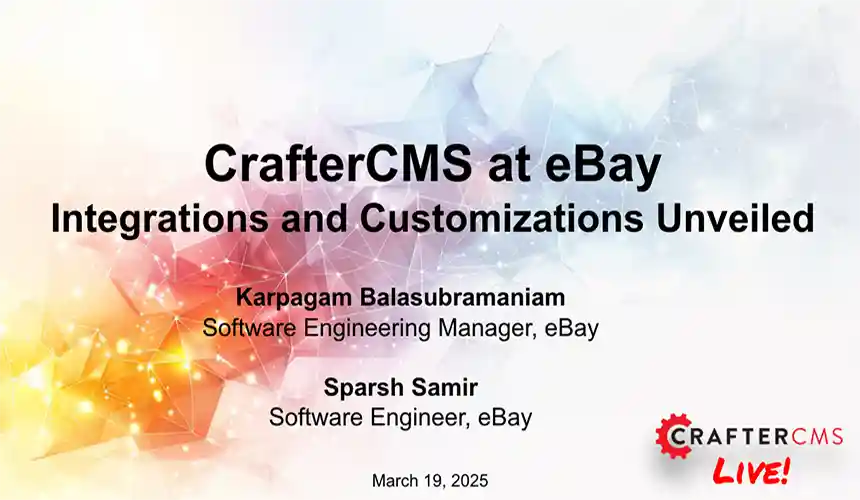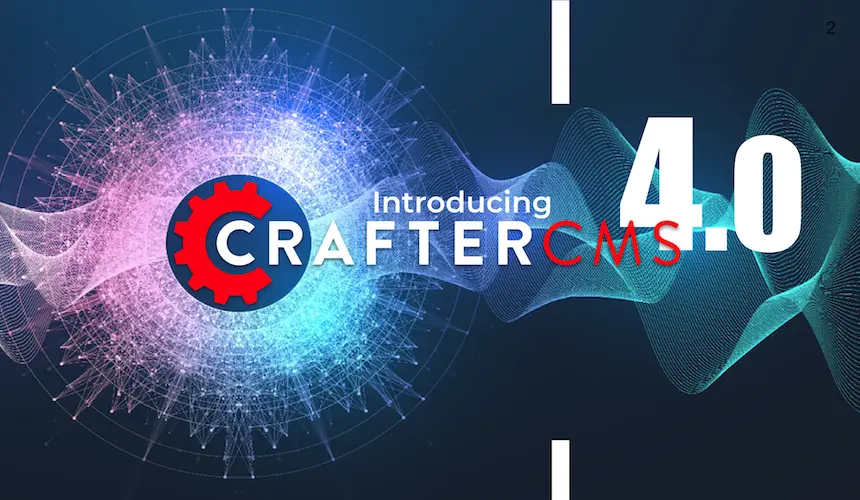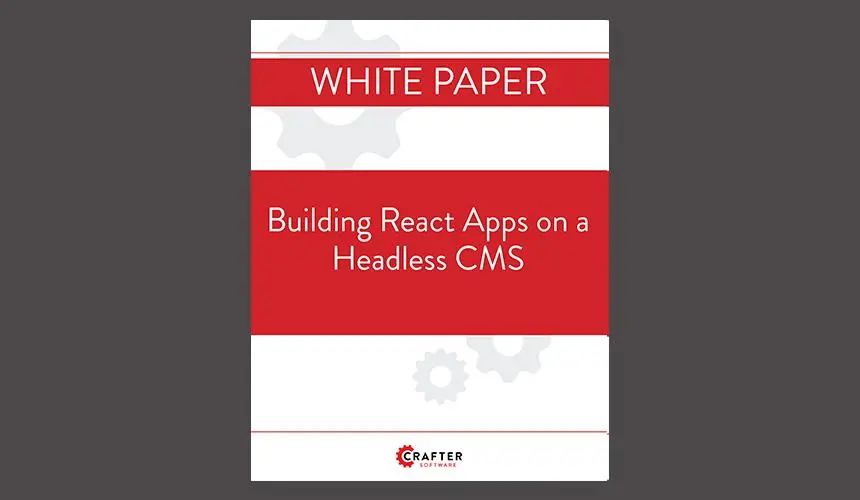Composable DXP vs Traditional DXP: Why Enterprises Choose CrafterCMS

Amanda Jones

Digital experience has become the competitive battlefield for modern enterprises. Whether you’re building websites, e-commerce sites, mobile apps, OTT video experiences, customer portals, IoT interactions, or emerging conversational interfaces, organizations need a content foundation that can keep up with rapid innovation, multi-channel complexity, and constantly evolving customer expectations.
This has created a clear divide in the CMS and DXP market:
-
Traditional DXPs (Adobe Experience Manager, Sitecore, Acquia/Drupal, Magnolia, Liferay, Optimizely, etc.)
-
Composable DXPs (API-first, microservices-friendly, cloud-native platforms that integrate best-of-breed services)
And that’s where CrafterCMS stands out by delivering a uniquely powerful, enterprise-grade Composable DXP that marries the flexibility of headless CMS with the productivity of rich content authoring and DevContentOps.
In this post, we break down the differences between traditional DXPs and composable DXPs, why the industry is shifting, and how CrafterCMS provides an unparalleled foundation for the future of digital experiences.
What Is a Traditional DXP?
Traditional DXPs (e.g., Adobe Experience Manager (AEM), Sitecore, Acquia, Magnolia, among others) evolved from older web CMS platforms. They typically share several characteristics:
1. Monolithic architectures
A single, tightly integrated system that bundles:
-
CMS
-
digital asset management
-
personalization engine
-
analytics
-
marketing automation
-
forms tools
-
proprietary extensions
These systems often create vendor lock-in and limit enterprise agility.
2. Heavy operational complexity
Traditional DXPs require:
-
large DevOps teams
-
expensive licensing
-
long deployment cycles
-
strict upgrade paths
-
complex hosting and scaling models
Innovation slows down when every change needs a release cycle.
3. “Page-centric” heritage
Built around website publishing, not modern digital ecosystems.
4. Limited developer freedom
Frameworks and tooling are dictated by the vendor, restricting developers who want to work with modern JavaScript frameworks, microservices, cloud-native patterns, or emerging AI workflows.
What Is a Composable DXP?
A Composable DXP replaces the monolithic approach with a modular architecture where each core capability can be chosen independently:
-
Best-of-breed CMS
-
Best-of-breed search
-
Best-of-breed commerce
-
Best-of-breed personalization
-
Best-of-breed AI services
-
Best-of-breed analytics
-
Any front-end framework
-
Any cloud platform
Composable DXPs are typically:
-
API-first and headless
-
Cloud-native
-
Framework-agnostic
-
Built around microservices
-
Integrated via standards (REST, GraphQL, webhooks, events)
-
Friendly to DevOps, GitOps, and automation
This composability gives enterprises the flexibility to design their own digital experience stack that is optimized for speed, cost, innovation, and future adaptability.
Why Enterprises Are Moving Away from Adobe, Sitecore, and Acquia
Across industries, enterprises are abandoning traditional DXPs because:
1. Monoliths slow down digital innovation
Long release cycles + vendor-controlled roadmaps = reduced agility.
2. Lock-in increases TCO and limits experimentation
Extending or modernizing monolithic DXPs often requires costly add-ons, specialists, and proprietary tooling.
3. Multi-channel experiences are now the norm
Modern digital ecosystems require:
-
digital commerce
-
mobile apps
-
IoT devices
-
kiosks
-
OTT video apps
-
AI chat interfaces
-
3D and AR experiences
Traditional DXPs weren't built for this.
4. Enterprises demand modern developer workflows
Developers now expect:
-
Git-based workflows
-
CI/CD
-
containerization
-
serverless deployment options
-
JavaScript frameworks
-
microservices flexibility
Legacy DXPs often resist these patterns or require heavy customization to support them.
5. AI is changing everything
Enterprises want:
-
AI-assisted content generation
-
AI taxonomies
-
AI personalization
-
AI automation across workflows
-
AI agents interacting with CMS data
- Conversational AI experiences for their site visitors
Traditional DXPs are struggling to retrofit AI onto aging architectures.
Why Enterprises Choose CrafterCMS for Their Composable DXP
CrafterCMS stands apart by delivering a true next-generation composable DXP foundation with capabilities that no traditional platform can match.
1. A Truly Headless, API-First, Git-Based Architecture
CrafterCMS is uniquely built on:
-
Git for content repository, along with its advanced versioning, rollback, history, auditing, branching capabilities
-
API-first content delivery
-
API-first authoring (fully decoupled from content delivery too)
-
API-first automation (DevContentOps)
This gives both developers and content teams unparalleled speed, governance, and flexibility.
Unlike traditional DXPs, CrafterCMS:
-
supports any front-end framework
-
supports stateless, serverless, multi-region deployments
-
makes DevOps dramatically simpler
-
provides a real content-as-code workflow
This is why Fortune 100 companies choose CrafterCMS for global-scale web, mobile, OTT apps, and next-gen digital platforms.
2. Enterprise-Grade Authoring Experience (Traditional DXPs fall short here)
While many headless CMSs offer simple markdown editors, Crafter Studio delivers:
-
WYSIWYG and live in-context editing
-
Drag-and-drop components
-
No-code content modeling
-
Workflow automation
-
Content previews across channels
-
Scheduled publishing
-
Governance
This mirrors the authoring power of AEM and Sitecore, without the monolithic weight.
3. Built for Composability and MACH Architecture
CrafterCMS naturally aligns with MACH principles:
-
Microservices-friendly
-
API-first
-
Cloud-native
-
Headless
This makes it inherently modular and easy to integrate with:
-
commercetools
-
BigCommerce
-
Salesforce
-
Stripe
-
OpenSearch (bonus: it's already pre-integrated into CrafterCMS's authoring and delivery systems)
-
Elasticsearch, Algolia, other 3rd party search engines
-
personalization engines
-
analytics stacks
-
AI agent platforms like CrafterQ
CrafterCMS doesn’t force a proprietary stack. You design your stack your way.
4. DevContentOps®: The Missing Capability in Every Traditional DXP
CrafterCMS invented DevContentOps, a framework that unifies:
-
content operations
-
development operations
-
collaboration across teams
-
automation
-
Git-based workflows
-
CI/CD-compatible CMS deployments
Traditional DXPs treat content and code as separate worlds, and this blocks collaboration and slows delivery.
With CrafterCMS, developers and content authors work faster together.
5. Composable, Scalable, Cloud-Native Delivery Engine
CrafterCMS Engine is:
-
stateless
-
serverless-friendly
-
multi-region ready
-
infinitely scalable
-
low-latency
-
secure by design
Enterprises get global digital experiences that perform flawlessly at any scale.
AEM, Drupal and Sitecore and other database-centric DXPs require heavy clusters, load balancers, and complex hosting. CrafterCMS just deploys and scales.
6. AI-Native Capabilities (Next-Gen Experiences)
CrafterCMS offers:
-
AI plugins
-
MCP-native integrations
-
AI-powered content creation
-
AI-assisted workflows
- Built-in vector database for building AI apps
-
RAG-powered search and recommendations
-
seamless integration with CrafterQ AI agents (authoring and delivery)
Enterprises can embed generative AI into every layer of their digital operations, which is something monolithic DXPs simply cannot match.
Summary: The Future Belongs to Composable DXPs
Monolithic DXPs had their day, but enterprise requirements have evolved. The future demands:
-
faster innovation
-
unlimited composability
-
modern developer workflows
-
low operational overhead
-
multi-channel reach
-
AI-native capabilities
-
open, API-first architectures
CrafterCMS uniquely delivers all of this by combining the freedom of headless CMS with the productivity of a full authoring suite and the agility of DevContentOps.
This is why enterprises that are replacing Adobe Experience Manager, Sitecore, Acquia, Magnolia (and other legacy DXPs) are choosing CrafterCMS as their Composable DXP for the next decade of digital experiences. Try CrafterCMS for free today.
Related Posts

Is Your CMS MACH-Ready? A Practical Guide for Enterprise Architects

Sara Williams

Connecting Content and Campaigns: Integrating CrafterCMS with Salesforce Marketing Cloud

Sara Williams

From Content Author to AI Co-Creator: The Next Evolution of CMS Workflows with MCP

Amanda Lee

Building Resilient Digital Experiences: Multi-Region Deployment Strategies with Crafter Cloud on AWS

Sara Williams



